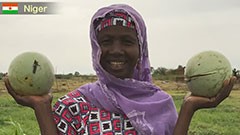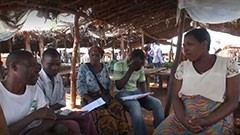What is the SHEP Approach?

Successful examples that increased farmers' income highly are reported one after another from countries where the SHEP Approach has been introduced.
The SHEP Approach, developed in Kenya, is the agricultural extension method that transforms farmers' mindsets from "grow and sell" to "grow to sell". It supports the increase of farmers' income by market-oriented farm techniques and improvement of the way of sales and has expanded to about 50 countries in the world as a new pillar of agricultural development. Successful examples that increased farmers' income highly are reported one after another from countries where the SHEP Approach has been introduced.
For example, in Kenya's project that had already finished in 2020, it was observed that the targeted farmers' incomes increased more than doubled. And, in Malawi, there were visible effects such as building and repairing farmers' houses in a short period of time
Because SHEP implementers were fostered mainly by JICA Knowledge Co-Creation Programs (KCCP), we produced JICA-Net multimedia-based learning material, "The SHEP Approach Training Digest" (external link) , which organized the contents of KCCP as a digest.
Introduce the practice of the SHEP approach
Because the SHEP approach was developed based on numerous insights acquired from agricultural extension in Japan, the work of those associated with farming and agricultural product distribution in Japan is closely related to SHEP activities.
In the first half, the material introduces Japan's agriculture and agricultural product distribution mainly in Obihiro, Hokkaido, as examples of "proactive farmers" and stakeholders involved in agriculture who support those farmers, who are both a part of the root of Japan's agricultural extension.

In market survey, farmers visit market and correct information.
In the second half, it explains the concept of the SHEP approach followed by various activities and their tips implemented in the world. Under the SHEP approach, extension activities are implemented with farmers in 4 steps. It was designed in a way they will be able to increase their motivation and take initiative in their activities by following those steps in order.
In the SHEP approach's concrete activities part, the material enables people to understand and image SHEP's practice easily by introducing the examples of JICA's experiences in the activity fields with many videos and local voices.
Aiming for the agriculture to sell

We already introduced trainees to the material in KCCP as a new material of SHEP.
JICA has the goal of expanding the agricultural extension service that uses the SHEP approach to one million farmers by 2030. For its achievement, JICA plans to foster 10,000 SHEP masters who deeply understand the SHEP approach and practice it for farmers. We produced the material for all those people.
Concretely, we will utilize the material for the SHEP training in activity sites in the world, self-prior learning for KCCP, SHEP implementers (government, donors, private sectors and so on) to learn the basics of the SHEP approach, and training the experts including the Japanese specialists.
We already introduced trainees to the material in KCCP " Market-oriented Agriculture Promotion (Planning and Management) (B)" as a new material of SHEP.
It is also useful as a material to learn the practical agricultural extension in a lecture in university. Actually, there was the example of incorporating SHEP to modules in courses to learn the practical agricultural extension in university. We expect that the material could be used even in such classes in the future.
Because we intend that the material will be watched in the world, the language of the material is not only Japanese, but also translated to English, French, Spanish, Russian and Arabic. It is also expected for the audiences to systematically deepen their understanding of the SHEP approach remotely and increase fans all over the world.
* SHEP teaching materials & public relations that are introduced at the end of the material are put on the below JICA webpage. Please utilize them.
FUKUDA Akiko
JICA Economic Development Department
*The Material(s) mainly applied
The SHEP Approach Training Digest
The SHEP approach that successfully transforms farmers' mindsets from "grow and sell" to "grow to sell" was developed based on numerous insights acquired from agricultural extension in Japan. This material explains the concept of SHEP approach followed by various activities and their tips implemented in the world.
At the Seventh Tokyo International Conference on African Development (TICAD VII) held in 2019, "SHEP One Million Declaration" was made to expand the SHEP approach to one million farmers by 2030. The contents of this material are based on the JICA's SHEP training conducted in JAPAN to foster SHEP implementers. It is expected for the audiences to deepen understanding of the SHEP approach and become fans all over the world.




scroll